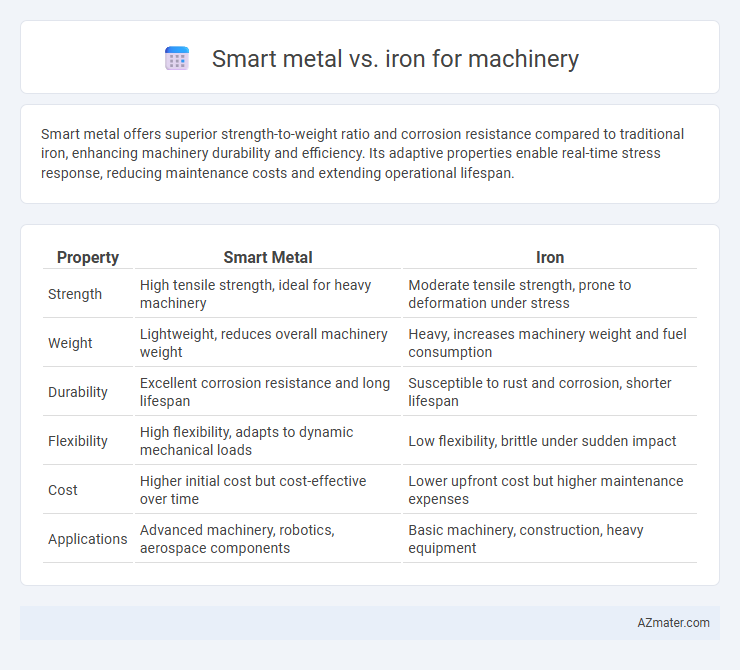Smart metal offers superior strength-to-weight ratio and corrosion resistance compared to traditional iron, enhancing machinery durability and efficiency. Its adaptive properties enable real-time stress response, reducing maintenance costs and extending operational lifespan.
Table of Comparison
| Property | Smart Metal | Iron |
|---|---|---|
| Strength | High tensile strength, ideal for heavy machinery | Moderate tensile strength, prone to deformation under stress |
| Weight | Lightweight, reduces overall machinery weight | Heavy, increases machinery weight and fuel consumption |
| Durability | Excellent corrosion resistance and long lifespan | Susceptible to rust and corrosion, shorter lifespan |
| Flexibility | High flexibility, adapts to dynamic mechanical loads | Low flexibility, brittle under sudden impact |
| Cost | Higher initial cost but cost-effective over time | Lower upfront cost but higher maintenance expenses |
| Applications | Advanced machinery, robotics, aerospace components | Basic machinery, construction, heavy equipment |
Introduction to Smart Metal and Iron in Machinery
Smart metal, an advanced material incorporating sensors and actuator capabilities, enhances machinery performance through self-monitoring and adaptive responses, improving durability and precision. Iron, a traditional metal widely used in machinery, offers strength and cost-effectiveness but lacks intelligent properties, leading to increased maintenance and potential downtime. The integration of smart metals in machinery revolutionizes operational efficiency by enabling real-time diagnostics and automated adjustments, surpassing the limitations of conventional iron components.
Composition and Properties of Smart Metals
Smart metals, often composed of alloys like nickel-titanium (Nitinol) or copper-aluminum-nickel, exhibit unique properties such as shape memory and superelasticity, enabling them to return to their original form after deformation. Unlike traditional iron, which primarily consists of iron with carbon and other elements for strength, smart metals have precise atomic structures that respond to temperature and stress changes, enhancing adaptability in machinery components. These advanced properties make smart metals ideal for applications requiring flexibility, durability, and self-healing capabilities in dynamic mechanical environments.
Traditional Iron: Strengths and Limitations
Traditional iron offers reliable tensile strength and durability vital for heavy machinery components, making it a cost-effective choice in industrial applications. However, its susceptibility to corrosion and lower resistance to wear compared to smart metal alloys limits its lifespan and performance in harsh environments. Maintenance requirements and the potential for structural degradation under stress highlight the need to consider alternative materials for enhanced machinery efficiency.
Smart Metal: Advanced Features and Functionalities
Smart metal incorporates advanced features such as self-healing properties, corrosion resistance, and adaptive strength, making it ideal for machinery exposed to harsh environments. Unlike traditional iron, smart metal can respond to changes in temperature and stress, enhancing durability and reducing maintenance needs. Its embedded sensors and real-time monitoring capabilities significantly improve machinery performance and operational efficiency.
Comparative Durability: Smart Metal vs Iron
Smart metal alloys exhibit superior wear resistance and corrosion resistance compared to traditional iron, enhancing machinery longevity in harsh environments. Iron's susceptibility to rust and fatigue under mechanical stress limits its durability for high-performance applications. Advances in smart metal technology optimize structural integrity and self-healing properties, making them more reliable for sustained heavy-duty machinery use.
Cost Analysis: Smart Metal versus Iron
Smart metal offers a higher upfront cost compared to traditional iron, driven by advanced manufacturing processes and material enhancements that improve durability and performance in machinery applications. Iron, while less expensive initially, typically incurs greater long-term maintenance and replacement expenses due to susceptibility to corrosion and wear. Evaluating total cost of ownership reveals smart metal's potential for reduced downtime and lower lifecycle costs, making it a cost-effective investment for high-precision or high-load machinery components.
Application Suitability in Modern Machinery
Smart metals, such as shape memory alloys and nitinol, offer superior application suitability in modern machinery due to their unique properties like high corrosion resistance, elasticity, and responsiveness to temperature changes, making them ideal for precision actuators and adaptive components. Iron, while widely used for its strength and cost-effectiveness, often lacks the advanced mechanical properties required for smart, responsive systems, limiting its application in cutting-edge machinery requiring lightweight and flexible materials. The integration of smart metals enhances machinery efficiency and durability in sectors like aerospace, robotics, and automotive industries, where adaptive and multifunctional materials are critical.
Maintenance and Longevity Factors
Smart metals, such as shape memory alloys and titanium alloys, offer superior corrosion resistance and self-healing properties, significantly reducing maintenance efforts compared to traditional iron used in machinery. Iron, while strong and cost-effective, is prone to rust and wear, necessitating frequent maintenance and shorter service intervals. Enhanced durability and lower degradation rates in smart metals contribute to extended machinery lifespan, optimizing long-term operational efficiency.
Sustainability and Environmental Impact
Smart metals, such as shape memory alloys and advanced composites, offer enhanced sustainability over traditional iron due to their durability and recyclability, reducing the frequency of replacements and waste generation in machinery applications. Iron, while abundant and recyclable, often requires energy-intensive extraction and processing, leading to higher carbon emissions and environmental degradation. Employing smart metals in machinery can significantly lower ecological footprints by optimizing material usage and enabling longer lifecycle performance.
Future Trends in Machinery Materials
Smart metals offer enhanced adaptability and self-healing properties, making them a key focus in future machinery material innovations compared to traditional iron. Advances in nanotechnology and alloy engineering enable smart metals to improve performance, reduce maintenance costs, and increase machinery lifespan. The growing demand for lightweight, high-strength, and corrosion-resistant materials drives the shift from iron toward smart metal composites in next-generation machinery design.

Infographic: Smart metal vs Iron for Machinery
 azmater.com
azmater.com